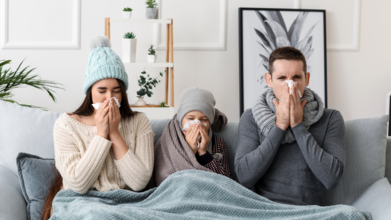- Health Conditions A-Z
- Health & Wellness
- Nutrition
- Fitness
- Health News
- Ayurveda
- Videos
- Medicine A-Z
- Parenting
- Web Stories
4 Early Signs Of Dementia That Are Unrelated To Memory Loss

(Credit-Canva)
Affecting millions of people all over the world, dementia is the current seventh leading cause of death globally. The World Health Organization states that 57 million people had dementia in 2021, the most common form of it being Alzheimer which contributes to 60-70% of cases. One of the most devastating things about this disease is that there is no cure for it. Researchers have been studying the disease in various contexts, but there are still many aspects of this mental condition that we are not aware of.
While there is no cure for the disease, getting treatment for dementia helps you minimize the symptoms and sustain your quality of life. The best way to deal with dementia is catching it early. That will allow healthcare professionals to give you the best possible treatment.
Important Symptoms That Go Unnoticed
When people think of dementia, memory problems are usually the first thing that comes to mind. However, there are many subtle signs of the disease that we might miss. A dementia diagnosis comes with the understanding that the disease can change a person’s entire being, the way they think, how they behave, even their core values that make up the person’s identity.
Understanding and addressing these sensory issues earlier could make a huge difference. It could help healthcare providers offer the crucial emotional and social support that patients need during what can be a very confusing and upsetting time. Plus, recognizing changes in a person's senses can also help doctors determine a dementia diagnosis. These signs are unrelated to simple memory loss.
How Dementia Changes How We See and Hear
Dementia often affects how a person experiences the world, changing how they understand what they see and hear. The Alzheimer’s Society explains that this happens because dementia damages the brain, leading to things like seeing shadows as objects or mistaking family members. These changes can be very confusing and upsetting for the person and their loved ones, making supportive responses crucial to maintain their confidence. A sudden, quick change could be serious, so call a doctor right away.
Difficulties with Hearing and Understanding Sounds, Especially in Noisy Places
Losing hearing in middle age (40-65) can increase your risk of dementia, and sometimes, hearing problems are an early sign. According to the Alzheimer’s Society as we age, hearing often declines, making it harder to hear clearly, especially in busy places. There are two types: one where ears don't pick up sounds well, and another where the brain struggles to process sounds. Getting your hearing checked and using hearing aids can help reduce dementia risk and improve memory and thinking skills. Protecting your hearing early in life is also important.
A Reduced Sense of Smell and Taste
Our sense of smell, often underestimated, provides vital information and can be an early indicator of dementia. According to the University of Chicago, research shows a rapid decline in smell can predict changes in brain regions linked to Alzheimer's disease, even before memory problems appear. This discovery could lead to simple smell tests for earlier detection of cognitive decline. While more research is needed, this inexpensive tool offers hope for identifying those at higher risk sooner, potentially leading to better treatments.
Problems with How We Feel Touch
According to a 2023 study published in the eBioMedicine, while hearing and vision are often studied, research now shows that changes in our sense of touch can also be linked to cognitive decline. Studies have found that people with mild cognitive impairment often have reduced sensitivity to touch compared to others. This means they might not feel things as clearly. This connection between touch sensitivity and memory suggests that looking at all our senses, not just sight and hearing, is important for understanding how the brain changes as we age and its role in conditions like dementia.
Flu Season In 2025 Is Here To Stay, Here's How You Can Disinfect Your House

Credits: Canva
The Centers for Disease Control and Prevention (CDC) has issued its 2025-26 outlook, predicting a respiratory virus season with similar peak hospitalizations from COVID-19, influenza, and respiratory syncytial virus (RSV) as last year. The agency also warns that COVID-19 hospitalization rates could rise if a variant with moderate immune-escape properties emerges.
While avoiding sick individuals is the first line of defense against the flu, cleaning and disinfecting your home after someone recovers is equally important to prevent the virus from spreading to others.
Cleaning vs. Disinfecting: Understanding the Difference
Before tackling flu germs, it’s crucial to understand the difference between cleaning and disinfecting. Cleaning removes visible dirt, dust, and germs using soap and water, while disinfecting targets remaining germs with products like sprays, wipes, or bleach. Experts recommend cleaning first, then disinfecting, for maximum effectiveness.
Focus on High-Traffic Surfaces
Viruses can survive on surfaces for up to 48 hours and on unwashed hands for about an hour. High-traffic areas in your home are most likely to harbor germs. Prioritize disinfecting:
- Doorknobs and drawer handles
- Light switches
- Stair rails
If someone was sick in a vehicle, disinfect frequently touched surfaces such as steering wheels, door handles, seats, and seat belts. Disinfecting wipes are convenient, but always follow manufacturer instructions and wash your hands afterward.
Kitchen and Bathroom Cleaning
In the kitchen, wash all utensils, dishes, and glasses in hot, soapy water or a dishwasher. Then disinfect:
- Countertops and cabinets
- Refrigerator handles
- Sinks and faucets
- Coffee makers, microwaves, and ovens
- Garbage cans
For bathrooms, disinfect:
- Toilets, sinks, and faucets
- Doorknobs and light switches
- Shower and bathtub surfaces
- Soap dispensers and toilet paper holders
- Floors and overlooked areas like toothbrush holders
- Consider replacing toothbrushes to prevent lingering germs
- Laundry and Bedroom Surfaces
Flu viruses can survive on soft surfaces like clothing, bedding, and towels. Wash all laundry in the hottest water recommended on care labels and dry thoroughly. Also, disinfect laundry baskets or hampers.
In bedrooms, disinfect doorknobs, bedside tables, bed frames, and drawer handles. Vacuum carpets and mop hard floors. For children, machine-wash soft toys and clean hard toys with soap and disinfectant.
Electronics Are Germ Hotspots
Mobile phones, keyboards, tablets, and remote controls can carry harmful microorganisms. Clean screens with a soft, lint-free cloth dampened with soapy water, or use disinfecting wipes carefully, avoiding alcohol-based products that may damage electronics. Consider wipeable covers for easier disinfecting.
Ventilate Your Home
Open windows if outdoor temperatures are comfortable. Fresh air reduces airborne germs and helps when using disinfecting products. Proper ventilation ensures that lingering viruses don’t continue to spread indoors.
Recovery First, Deep Cleaning Later
If you are still recovering from the flu, wait until you feel well before doing intensive cleaning. Recovery typically takes a week, but may take longer for those with underlying conditions or complications. Enlist help from family, friends, or professionals to avoid overexertion.
Flu is highly contagious, particularly when people spend more time indoors. Cleaning and disinfecting your home after recovery is vital to prevent spreading the virus. Start with high-traffic areas, then move to kitchens, bathrooms, bedrooms, and electronics. Always wear gloves and a mask when using disinfectants and follow instructions carefully.
By taking these precautions, you help protect your household and visitors from catching the flu, ensuring a safer and healthier home this season.
Fatty Liver Risk Rising? Harvard Doctor Says These 3 Everyday Foods Could Be To Blame

(Credit- Canva)
A disease that slowly creeps in and affects one of the vital organs, may sound terrifying and rare, but it is more common than we realize. Fatty liver diseases are one of the most common form of liver diseases in children, and this number has doubled in the past 20 years.
According to the American Liver Foundation. About 100 million people in the US have MASLD, or Metabolic dysfunction-associated steatotic liver disease, which was previously known as NAFLD. This happens when the percentage of fat in the liver is more than 5%-10% of the liver’s weight. While you may think that it doesn’t affect your health as much, but it can actually cause you a lot of issues.
How Does Fatty Liver Affect Your Health?
Your liver is a vital organ that processes food and waste in your body. A healthy liver should contain very little fat. Over time, too much fat can lead to scarring of the liver, a serious condition called cirrhosis. Fatty liver is common, affecting about one in three adults, according to Australian Healthdirect.
Fatty liver disease often has no symptoms. However, if symptoms do appear, they may include feeling tired or unwell, having pain in the upper right part of your stomach, or losing weight without trying. More serious signs that the disease has progressed and caused liver damage include:
- Jaundice: When your skin and the whites of your eyes turn yellow.
- Bruising easily.
- Dark-colored urine.
- A swollen stomach.
- Vomiting blood or having black stools.
- Itchy skin.
What Should We Avoid To Make Our Liver Healthy?
Cases of fatty liver disease are on the rise, largely due to poor dietary habits and a reliance on processed foods. While this condition can lead to serious health issues over time, making a few simple changes to what you eat can significantly reduce fat buildup in the liver and lower your risk of liver disease. Gastroenterologist Dr. Saurabh Sethi, who is trained at top universities, recently shared his top three food choices that can harm your liver. According to Dr. Sethi, you should avoid the following three common foods to protect your liver:
Sugary Drinks
Dr. Sethi calls sugary drinks like sodas and juices "liquid poison" because they are full of empty calories. Drinks that contain high-fructose corn syrup can overwhelm the liver, causing it to turn the extra sugar into fat. This process contributes directly to fatty liver disease. Instead, Dr. Sethi recommends sticking to water, tea, or coffee.
Deep-Fried Foods
Foods that are deep-fried, especially in unhealthy oils, should be avoided. They contain high amounts of unhealthy fats that can lead to fat buildup and inflammation in the liver. This can cause liver damage and contribute to obesity and non-alcoholic fatty liver disease.
Ultra-Processed Foods
Items like chips, candies, hot dogs, and instant noodles are highly processed and harmful to your liver. These foods are full of unhealthy fats, added sugars, and artificial ingredients that put a strain on your liver, leading to inflammation and an unhealthy gut.
Dr. Sethi stresses that making these simple dietary changes can make a big difference in protecting your liver's health.
FDA Food Recall: Popular Cookies Recalled Due To Undeclared Ingredients, 'Threat-To-Life' Warning Issued

(Credit- Canva)
Gina Marie Bakery, a company located in Connecticut, has issued a voluntary recall for several of its cookie products. The recall was announced after the company discovered a major issue with its packaging: it failed to list some important ingredients.
Specifically, the cookies may contain almonds, sesame, and several food colorings without declaring them on the label. The company is taking this action to ensure customer safety and has stopped all sales of the affected products until the problem is completely fixed.
How Dangerous Are Allergens In Food?
The recall is a serious matter because of the health risks involved. For people with allergies to nuts, sesame, or certain food dyes, eating these cookies could cause a severe or even life-threatening allergic reaction.
Reactions can range from mild symptoms like hives and lip swelling to a dangerous condition called anaphylaxis, which can make it hard to breathe and can be fatal. Thankfully, no illnesses have been reported so far. This recall is a proactive step to prevent anyone from getting sick due to the incorrect labeling.
What Were The Major Allergens In Gina Marie Bakery?
The recall includes several types of cookies sold in 1-pound and 2-pound plastic containers. The specific products are Italian Mixed Vanilla Cookies, Italian Sesame Cookies, and several others, all of which were distributed to various stores in Connecticut and parts of Massachusetts. If you have any of these cookies in your home, it's very important that you do not eat them. Instead, you should return them to the store where you bought them for a full refund. If you have any questions or concerns, you can call the company directly at 203-596-8007. Here are the specific products listed
- Italian Mixed Vanilla Cookies
- Italian Sesame Cookies
- Vanilla Chocolate Dipped Cookies
- Vanilla with Apricot Jam Cookies
- Toasted Almond & Cherry Biscotti
- Vanilla Cookies with Raspberry Peach Jam
How To Respond During Emergency Allergic Reaction
In case you have consumed an allergen or believe you are having an allergic reaction, ensure that you take proper steps for the best outcomes. Anaphylaxis, which is a severe allergy reactionm is a very serious allergic reaction and a medical emergency. It requires immediate treatment with an adrenaline (epinephrine) injector, as a delay can be fatal. It’s important to know the difference between a mild reaction and a severe one.
Signs of a mild reaction:
- Swelling of the lips, face, or eyes
- Hives or welts on the skin
- A tingling feeling in the mouth
- Stomach pain or vomiting (especially after an insect sting)
What to do:
If you see these signs, stay with the person and call for help. Get the adrenaline device ready in case the reaction gets worse. A mild reaction might not always happen before a severe one begins.
Signs of Severe Allergic Reaction
Anaphylaxis is life-threatening. Look for any one of these signs:
- Breathing Trouble: Noisy breathing, a persistent cough, or wheezing.
- Throat and Mouth Swelling: A swollen tongue or a feeling of a tight throat.
- Voice Changes: A hoarse voice or difficulty talking.
- Dizziness or Collapse: Feeling dizzy, fainting, or collapsing.
- In Children: A young child may become pale and limp.
What To Do When A Person Is Having An Allergic Reaction?
- You must ensure that you act immediately if someone is having an allergic reaction in front of you.
- Lay the person flat. Do not let them stand or walk. If they are unconscious, put them on their side. If they are pregnant, lay them on their left side. If they have trouble breathing, let them sit with their legs out straight.
- Use the adrenaline device. Give the person their adrenaline shot right away.
- Call for an ambulance.
- Call their emergency contact. Let their family or contact person know what is happening.
- Give another shot if needed. If the person doesn't improve after five minutes, you may need to give a second dose of adrenaline.
- Go to the hospital. Even after the reaction seems to stop, the person must be taken to the hospital and watched for at least four hours.
- If the person becomes unresponsive or is not breathing normally, commence CPR
© 2024 Bennett, Coleman & Company Limited

